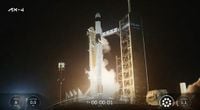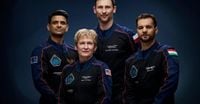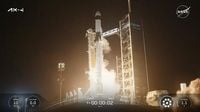In the early hours of June 25, 2025, a Falcon 9 rocket thundered into the Florida sky, carrying four private astronauts on a historic journey to the International Space Station (ISS). This mission, known as Ax-4, marks the fourth private spaceflight arranged by Houston-based Axiom Space, a company pioneering government-supported commercial space travel. The multinational crew launched from NASA’s Kennedy Space Center’s Launch Complex 39A at precisely 2:31 a.m. Eastern Daylight Time aboard a brand-new SpaceX Dragon spacecraft, aptly named "Grace" by the astronauts themselves shortly after reaching orbit.
The Dragon capsule’s maiden voyage followed a series of delays that tested patience and perseverance. Initial launch attempts were thwarted by high-altitude winds and a liquid oxygen leak in the Falcon 9 booster. More critically, NASA and its Russian partner Roscosmos postponed the mission to investigate a "new pressure signature" detected in the ISS’s Zvezda Service Module, which has been plagued by a persistent air leak for over five years. After careful evaluation, NASA confirmed the module’s pressure was stable and gave the green light for the launch on June 23.
SpaceX’s Falcon 9 first stage successfully returned to Earth just over seven minutes after liftoff, landing safely at Landing Zone 1 at Cape Canaveral. The booster, designated B1094, was flying for the second time, demonstrating SpaceX’s ongoing commitment to reusability. Meanwhile, the Dragon capsule began its 28-hour journey to the ISS, scheduled to dock at approximately 7 a.m. EDT on June 26.
Commanding the mission is Peggy Whitson, a retired NASA astronaut and Axiom’s director of human spaceflight. Whitson is no stranger to space, holding the record for the most cumulative time spent in orbit by any U.S. astronaut—nearly 700 days after this mission. She has commanded the ISS twice before and led Axiom’s second mission to the station in 2023. "Every crew brings something new to the table," Whitson said before launch. "I've been incredibly impressed by the dedication and the work ethic and the passion of this team. It’s been a joy to train alongside them, and I’m looking forward to seeing them in microgravity. It’s going to be fun."
Joining Whitson are three astronauts from countries returning to human spaceflight after decades: Shubhanshu Shukla of India, who serves as pilot; Sławosz Uznański-Wiśniewski of Poland; and Tibor Kapu of Hungary, both mission specialists. Each is the second person from their respective countries to reach orbit and the first to visit the ISS, marking a significant milestone for their national space programs. India last sent an astronaut to space in 1984, Poland in 1978, and Hungary 45 years ago.
Shukla, a pilot in the Indian Air Force, aims to leverage this experience to help India become the fourth nation capable of independently launching humans into space. He was inspired by Rakesh Sharma, India’s first astronaut, who flew aboard a Soyuz mission in 1984. Uznański-Wiśniewski, born on the 23rd anniversary of Yuri Gagarin's historic flight, is a European Space Agency (ESA) project astronaut and an accomplished engineer who has worked at CERN. Kapu, the youngest crew member born in 1991, holds a master’s degree in polymer technology and has focused on space radiation protection, representing Hungary’s ambitions to join the global space community.
The Ax-4 mission is not only a commercial endeavor but also a scientific one. Over their roughly 14-day stay aboard the ISS, the crew will conduct about 60 scientific experiments—the highest number to date for an Axiom mission. These studies span biology, life and material sciences, technology demonstrations, and Earth observation. Thirty-one countries have contributed to the research plan, including Saudi Arabia, Brazil, Nigeria, and others. ESA supports 17 experiments, while Poland and Hungary contribute through their national astronaut programs. Additionally, joint activities between NASA and the Indian Space Research Organization (ISRO) will involve Shukla and NASA astronauts aboard the station.
The mission also serves as a stepping stone toward Axiom Space’s ambitious goal of building the world’s first commercial space station, Axiom Station. The company plans to attach commercial modules to the ISS during its remaining operational years. Once NASA retires the ISS around 2030, these modules will detach and form the foundation of the privately operated station.
Axiom’s partnership with NASA exemplifies the evolving landscape of spaceflight, blending public and private efforts. NASA’s private astronaut mission program offers commercial companies access to the ISS along with technical and logistical support, while the companies handle launch, free flight, and landing operations. "It's an incredible time for spaceflight," said NASA’s ISS Program Manager Dana Weigel. "These missions help train teams, build partnerships, and shape the future of low Earth orbit."
SpaceX’s Dragon program has been central to this new era, completing 52 launches and 17 human spaceflight missions, safely transporting 66 crew members from 17 countries and facilitating over 1,000 microgravity research experiments. The Dragon capsule remains the only U.S. spacecraft certified by NASA for astronaut transport to the ISS, a role it continues to fulfill amid Boeing’s Starliner delays.
Upon reaching orbit, Whitson announced the spacecraft’s name, "Grace," reflecting the elegance and goodwill embodied by spaceflight. "Grace reminds us that spaceflight is not just a feat of engineering but an act of goodwill for the benefit of every human everywhere," she said.
The crew's arrival at the ISS is highly anticipated, with a livestream of docking procedures scheduled to begin hours before the planned 7 a.m. EDT rendezvous on June 26. Once aboard, the Ax-4 astronauts will join the seven long-term ISS residents, including NASA astronauts Anne McClain, Nichole Ayers, and Jonny Kim, JAXA astronaut Takuya Onishi, and Russian cosmonauts Sergey Ryzhikov, Kirill Peskov, and Alexey Zubritsky.
The mission’s return is planned for the second week of July, with a splashdown off the coast of southern California. This will be the second crew recovery of a Dragon capsule off the U.S. West Coast, a shift prompted by concerns over debris from previous splashdowns off Florida.
As the Ax-4 mission unfolds, it stands as a testament to international collaboration, technological innovation, and the expanding commercial horizons of human spaceflight. For India, Poland, and Hungary, it’s a triumphant return to the cosmos; for Axiom Space and NASA, a vital step toward a future where low Earth orbit is a thriving commercial frontier.






